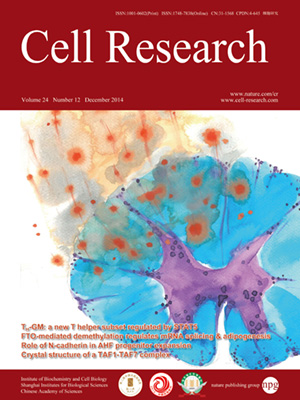
Volume 24, No 12, Dec 2014
ISSN: 1001-0602
EISSN: 1748-7838 2018
impact factor 17.848*
(Clarivate Analytics, 2019)
Volume 24 Issue 12, December 2014: 1486-1489 | Open Access
LETTERS TO THE EDITOR
Crystal structure of a bacterial homologue of SWEET transporters
Jing Wang1,2,3, Chuangye Yan1,2,3, Yini Li1,2,3, Kunio Hirata4, Masaki Yamamoto4, Nieng Yan1,2,3 and Qi Hu1,2,3
1State Key Laboratory of Bio-membrane and Membrane Biotechnology, Tsinghua University, Beijing 100084, China
2Tsinghua-Peking Joint Center for Life Sciences, Tsinghua University, Beijing 100084, China
3Center for Structural Biology, School of Life Sciences and School of Medicine, Tsinghua University, Beijing 100084, China
4Advanced Photon Technology Division, Research Infrastructure Group, SR Life Science Instrumentation Unit, 1-1-1 Kouto Sayo-cho Sayo-gun, Hyogo 679-5148, Japan
Correspondence: Nieng Yan, E-mail: nyan@tsinghua.edu.cn; Qi Hu,(huqi10@tsinghua.org.cn)
SWEETs represent a novel family of membrane sugar transporters that have been identified in plants, worms, and mammals. They selectively transport mono- or disaccharides across plasma or intracellular membranes, and are involved in a number of essential physiological processes1. The functions of SWEETs are best characterized in plants. In Arabidopsis thaliana, AtSWEET1/4/5/7/8/13 mediate glucose efflux1, AtSWEET11/12 function as sucrose transporters2, and AtSWEET17 permeates fructose3,4. These SWEETs are important for the growth and development of plants, and some are hijacked by pathogens or symbionts for their own sugar supply.
10.1038/cr.2014.144
FULL TEXT | PDF
Browse 2190


